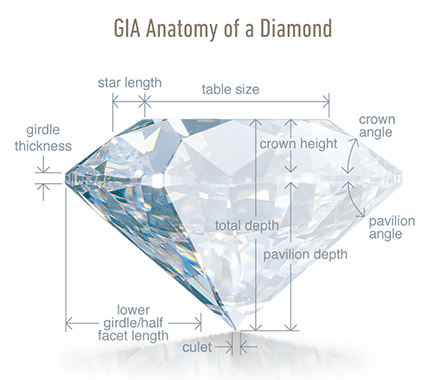Thinking about lab grown diamonds? This post will give you the most comprehensive deep dive into laboratory grown diamonds, giving you more knowledge than 90% of the sales people out there and making sure you are getting the best quality diamond.
Having been in the diamond industry for over 25 years, working as a diamond grader, gemmologist and valuer and owner of a diamond boutique, I can honestly say I really love diamonds. I am often asked questions about jewellery and gems, asking me to pick my favourite cut, colour, or stone and at the end of the day, I keep coming back to a diamond.
The questions I get asked more than most right now are all about lab grown diamonds; what exactly are they? Are they all created the same? Can you tell the difference, and most importantly should I consider buying one?
For me, whether it is a lab grown diamond or a mined diamond, I love both and either can be perfect for you depending on what you are looking for in your diamond. My wife wears both mined and lab grown diamonds and the origin for the stone has not been a contributing factor for me, but I understand for some it may be.
I am a big believer in arming yourself with all the correct information before deciding between lab grown diamond and mined diamonds and where to buy from. With the size of the diamond industry combined with the extensive amount of information on the internet, you might be finding it difficult to decipher what is correct and what is misinformation on created diamonds without the marketing agenda and spin.
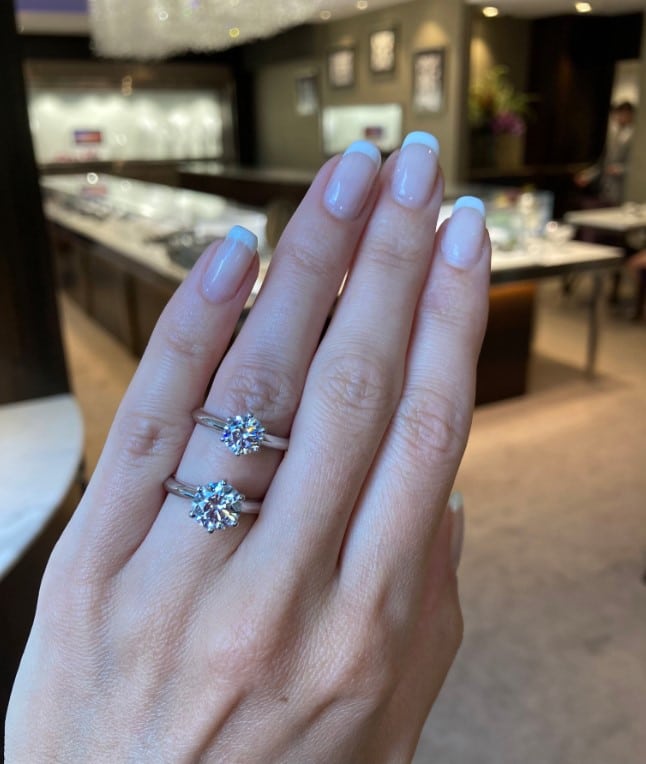
The first time I came across a lab grown diamond, I must confess I was quite sceptical. One of my suppliers had sent me an amazing two-carat diamond to look at. As I normally do, I checked the diamond for myself so I could grade it based on my own valuation. I looked at the colour, clarity, and the precision of the cutting, and was soon satisfied that I was indeed looking at an amazing diamond – one that would make someone incredibly happy to wear for the next 50 years. I then looked at the paperwork, and the first thing that struck me was the price. It was significantly less than what I was expecting considering the quality of the stone. I quickly rang the supplier to see if the pricing was a mistake and discovered it wasn’t. It was just the mining cost making the significant price difference.
Can an expert tell the difference? Can you?
I recently put myself to the test, to check whether I could tell the difference between a lab grown diamond and a mined diamond. I sat down, a little cocky, as the gentleman across the table from me presented 10 stones. I simply had to sort these into lab grown diamonds and mined diamonds.
I started as I always do, picking up my loop and tweezers, as familiar to me as a pair of shoes that fit perfectly. Picking up the first diamond, I noticed a dark black inclusion on the edge of the stone. This looked like a familiar graphite inclusion that I had seen 1000 times of more. Easy first one, I thought. This obviously belongs in the mined diamond group. The second diamond I picked up was completely clean, so I placed the stone back on the table, gave it a wipe with the special microfibre diamond cloth, rotated the stone and picked it up again. (A widespread practice when assessing diamonds is to rotate the stone to make sure the orientation of the inclusion isn’t hiding due to the angles of light bouncing around inside the stone.) Still nothing? Well, this must be either an incredibly clean diamond, or it must be a lab growndiamond, I thought. So, it went in the created diamond category.
Over and over, I went through this exercise until all ten stones were sorted. Announcing I was finished to my counterpart across the table with a little smile on my face, he asked me if I was sure and happy with my selection. To which my confidence slipped a little and I nervously replied, ‘Well, let me just have one quicker look.’ Having satisfied my curiosity, I decided I was happy with my selection. ‘How did I do?’ I (still somewhat nervously) asked him.
The gentleman now seemed to know something he was reluctant to share. ‘Well, the thing is,’ he said somewhat apprehensively, ‘they are all lab grown diamonds.’
What? How is this possible? I thought.
Realising that the game was up, I decided to have a look at all the diamonds I had marked as mined, scrutinising them from every angle. I had to conclude that, without sophisticate laboratory equipment, there really was no way to tell the difference between lab grown diamonds and mined diamonds, even with a 10x times magnifying lens.
At first, I wasn’t sure whether I should be happy or upset that I couldn’t tell the difference; however, what I ended up taking from the experience was that my original prejudices around the origin of creation had absolutely nothing to do with how the diamond presented and performed.
Are created diamonds better?
How could something that is created in a lab be better than something produced ‘naturally’? Well, lab grown diamonds being as good as, or better, than mined diamonds may not be as far-fetched as you think. After all, advancements in technology are happening every year, and things were previously thought impossible are now normal. We are talking about travelling to Mars and 3D printing meat, just to name but a few such innovations. So why not creating high-quality diamonds?
Aren’t all diamonds created?
When you really think about it, all diamonds are created. Some are just created by the earth, and some are created by humans. The process used to make diamonds today is essentially replicating the conditions that occurred below the ground over millions of years.
Mined diamonds are a billion years old, whereas a lab grown diamond can be anywhere from one to three months old, depending on the size and quality of the stone.
Apart from the time factor, the only real difference is that one diamond is made below the ground and the other is made above the ground. Essentially, only the origin is different for each.
Natural versus synthetic
Interestingly, in 2020 the US Federal Trade Commission (FTC) removed the word ‘natural’ when talking about a mined diamond. They argued it was impossible to have a synthetic element. We are either breathing oxygen right now or we aren’t, for example. The same goes with the carbon in a diamond – it is either carbon or it isn’t. A synthetic carbon simply doesn’t exist.
The other interesting point here is that most people can tell from a considerable distance that other gemstones are the created versions – for example, synthetic sapphires look like blue glass. There is something quite distinctive about most created gemstones, and they just look fake or unnatural – and so are significantly cheaper. A lab grown diamond, on the other hand, is indistinguishable from a mined diamond.
Simulate versus created
As opposed to a lab grown diamond, a simulate is something that is like but not the same thing. In terms of diamond simulates, this refers to stones such as a cubic zirconia (CZ). At a distant glance, they might look the same as a diamond, but they don’t have the same optical or hardness properties.
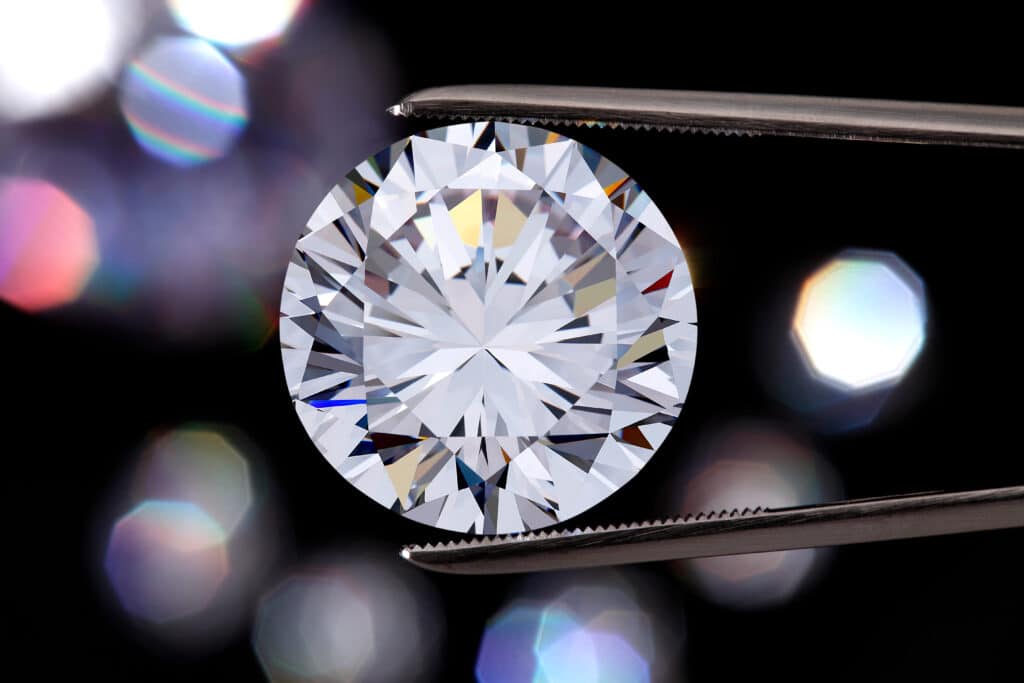
What about the negatives?
As I’ve discussed, lab grown diamonds can be of such high quality it’s almost impossible to separate them from mined diamonds. And you can buy this high quality at a fraction of the price of mined diamonds. So, you might be reading this and thinking that this sounds like the best thing since sliced bread. A bigger and better-quality diamond, for less? What’s the catch?
The main possible negatives relate to resale value for the diamond and whether it will hold its value.
Resale value
The truth is every diamond in the world is graded and valued for exactly what it is. If you pay $5000 less for a lab grown diamond now, for example, then it will be consistently worth at least $5000 less than the value of a comparable mined diamond.
Holding its value over time
I am not sure about you, but my crystal ball is on the fritz now, and I think anyone who tells you they know what the future holds should be treated with caution. What I do know is that all diamonds – mined and lab grown – move up and down in price. Many contributing factors influence the price of diamonds globally. When I recently checked the wholesale price of the diamond I purchased for my wife’s engagement ring, it had fallen $3000. (Of course, as I have mentioned, this is totally irrelevant to me, because I don’t plan on selling it.)
While it might be true that products often get cheaper as technology advances, prices are still governed by the age-old forces of supply and demand. Late in 2020, for example, we did see a drop in the prices of laboratory-created diamonds. However, 2021 has seen not only a stabilising of the market rates of created diamonds, but also signs of an increase in rates as demand outstrips supply.
These shortages are being exasperated further by delays in more reactors being built, which is placing further pressures on supply.
Looking at the diverse types of lab grown diamonds
Before I get any further into the features, benefits, pros, and cons of created, understanding the two distinct types of created diamonds currently on the market is important. Check out this video that shows the two growing procesess
High pressure and high temperature lab grown diamonds
HPHT, or high pressure and high temperature, lab grown diamonds, were first invented in 1954 by General Electric and were predominately used for industrial purposes.
In this process, the diamond is created from a ‘carbon seed,’ with typically a material such as graphite being used. Here they are essentially extracting the carbon from a solvent metal, under the required conditions of pressure (over 1.5 million pounds) and high heat (over 1400 °C) to grow the diamond. However, it wasn’t until the 1970s that gem-quality diamonds started to be produced.
While HPHT diamonds are created using several different processes, many of these diamonds exhibit yellowish and brownish tints due to their exposure to nitrogen when being formed. They can also contain metal-type inclusions such as iron, nickel, and cobalt. These types of inclusions area-typical in mined diamonds, and so are often something that allows experts to identify them as lab grown.
HPHT is also used as a post-growth treatment to turn diamonds that have a brownish or yellowish tint into ones in the colourless range of diamonds (that is, in the D to F range; refer to chapter 7). While the colour change produced post-growth using HPHT is permanent, it is important to be aware if the treatment has been used.
One distinguishing feature of HPHT grown diamonds is that they will often have fluorescence, and may not show up on a diamond tester as a diamond in all cases
The time frame for making a HPHT diamond is around one to two months.
Chemical vapour deposition
CVD, or chemical vapour deposition, created diamonds are different from HPHT diamonds in that the seed is an actual diamond, and the diamond is grown from a hydrocarbon gas mixture. This process is a more recent method for creating diamonds and has been used since the 1980s.
Considerably less heat (800 °C) is used, along with myriad other techniques to cause the carbon-rich gas to bond with the diamond seed crystal to allow it to grow.
The diamonds created during the CVD growth method are near colourless, attributed to the vacuum chamber in which they are created. This chamber limits the exposure to nitrogen and boron. When combined with what’s known as a Type 1a, or type 2a, diamond seed, this leads to a whiter finished diamond. (Type 1a diamonds are purely, or almost purely, carbon, and are the purest and most valuable of all – see the section ‘Under the microscope’ for more.) This means that the original creators found the most perfect diamond they could in nature and used this for the seed crystal, from which all the subsequent diamonds were created.
Another advantage of a CVD created diamond is that it will never show fluorescence – refer to chapter 7 for more on how diamonds with low or no fluorescence are graded.
In this process, the diamond seed is placed in the reactor and, over a period of one to three months, grows into the finished laboratory-grown diamond.
Checking the certificate
When buying a lab grown diamond, you need to check the comments section on the certificate to confirm the method used. Was it through HPHT or CVD? If created through CVD, does it specify that a Type IIa diamond was used?
Value of created diamonds
Creating diamonds is not like making a loaf of bread, where you put your ingredients into the mix and, if you follow the recipe, it comes out perfect every time. Creating diamonds has so many variables – relating to the required heat, pressure, time frames and growth rates – that it must be like controlling a spaceship and flying into space with Elon Musk. This variability leads to high fail rates, making the yield of the growth process incredibly unpredictable. Most created diamonds sit in the lower I to K range for colour and SI (G-K VVS-SI1) to I range for clarity (refer to chapter 7). This means that a created diamond in the D to F range for colour and in the VS range for clarity represents a small percentage of all diamonds that are created. If you’re sourcing such a diamond, you’re looking for something rare and hard to find (and so more valuable).
This, along with the millions of dollars already spent in R&D, means that the value of a created diamond falling as low as $1 is incredibly unlikely.
Under the microscope
Diamonds are almost entirely made of carbon. The type Ia diamond, for example, is made up of over 98 per cent carbon, along with trace elements of nitrogen and other minor impurities in them. The type IIa diamond is almost exclusively made up of just carbon. (These make up just 1 to 2 per cent of all mined diamonds.)
To get a better idea of the effect of trace elements on light performance, imagine you are looking through your car windscreen after having been driving for a couple of months. On the windscreen might be the general grime of pollution, putting a fine film on the surface, along the occasion bug that has hit your window and other nasties that have found their way on to your screen. All of this impairs the clean transparency of your vision. Now imagine your windscreen has been cleaned with a premium grade solution that has made it so clear you find it hard to tell there is a glass barrier there at all.
At a microscopic level, this is like the difference between the type Ia and type IIa diamond. While the difference may seem small, it makes a significant impact on your diamond’s appearance and value. The type IIa diamond just has a certain crispness to it, and this type is possible with created diamonds.
Interesting fact for the chemistry buffs on trivia night
Carbon has four covalent bonds and nitrogen only has three. As mentioned, a type Ia diamond has carbon and nitrogen. Having nitrogen in the diamond’s crystalline lattice structure means it absorbs blue light, which leaves yellow light being emitted. Therefore, the more nitrogen a diamond has, the more yellow it looks.
The type IIa diamond, on the other hand has almost no nitrogen, which leaves it facing up whiter.
Considering the Sarine Light Performance report
Along with the ‘four Cs’ of cut, colour, clarity, and carat weight (refer to chapter 7) a new measure of a diamond’s performance rates how it interacts with light – using the Sarine Light Performance rating. The highest light report ranking you can get using this system is an Ultimate3. With practice and skill, it is possible to select a stone that has the right proportions, cut, clarity and colour to achieve this ranking. However, it has been my experience that it is almost impossible for a mined diamond to reach this classification due to the quality of the crystal and the way the light travels through the crystal.
Achieving an Ultimate cut grade (which is higher than the standard GIA excellent cut – refer to chapter 7) means that you diamond will sparkle more, even when dirty. Diamonds in the Ultimate range are simply beautiful and hard to source, which makes them even more desirable. Laboratory created diamonds are more likely to achieve the Ultimate 3 ranking than mined diamonds.
Mined versus created – or taxi versus Uber
One of the things clients often say to me is that they prefer a mined diamond because they believe it to be ‘traditional’ – to which I usually ask them if they use an Uber or a taxi. Almost everyone says they use an Uber, and I then ask, ‘Why isn’t a taxi ‘traditional’?’
The funny thing about technology is that it is often first seen with sceptical eyes, before being slowly adopted, and finally accepted and seen as common place. Even something such as buying online and having your shopping delivered used to be viewed with apprehension – putting your credit card information and address into the website? What if someone fraudulently purchased something on your card? Now no-one gives it a second thought.
Are lab grown diamonds a young person diamond?
As a rule, I find the client age line for choosing a created diamond is around 45 years. While it might be said that younger people embrace technology faster than the more seasoned of us, it isn’t always the case.
I had a couple recently celebrating their 43-year wedding anniversary with a 4.6ct E VS1 round brilliant, created diamond. If they had wanted to go for a mined equivalent, they would have had to pay more than $120,000 extra.
Spend more, save more
While ‘spend more to save more’ might be a funny catchphrase aimed at getting you to spend more at the Christmas and Boxing Day sales, it really is true when it comes to diamonds. The bigger the created diamond that you choose, the more you save. At the time of writing, the average saving when purchasing a one-carat created diamond was $5000, while you could save $12,000 if purchasing a 1.5ct created diamond, and $25,000 on a two-carat one.
The conversation I often have with my clients is around what they could do with the extra money. For a lot of them, the money saved can go towards a house deposit, paying for the wedding or even a house renovation.
Clients often decide to either save the money they would have otherwise had to spend for a comparable mined diamond, or they keep their budget the same and increase the size and quality of the diamond they can afford to buy. Depending on the quality of the diamond you are looking at, for example, you can likely get around a 40 to 50 per cent bigger diamond for the same money. So, if you’re looking at a one-carat mined diamond, in a created diamond you would be looking at 1.5ct-plus size diamond, which is certainly a noticeable difference.
The other bonus factor you usually find in a created diamond is that the cost of upgrading your quality is substantially less. For example, upgrading to a diamond in the VS range for clarity from one in the SI range might cost $200 in a created diamond, but might be $1000 more in a mined diamond.
One of the joys of my profession is seeing happy clients after they have been proposed to. Usually, they come in and love to tell the story of how their partner proposed, and then proudly show off the ring their partner chose. What I have seen over the last two years is the elation that comes from their expectations being exceeded, not just in the size of the diamond, but in maximising the other three of the 4Cs – cut grade, colour, and clarity. Exceeding expectations in all areas becomes more possible when considering created diamonds.
You may already know that my wife and I have triplets (plus one). One of the questions I am often asked it is whether the triplet pregnancy was by IVF. While it wasn’t, I have had many families and friends who have had their children with the assistance of IVF.
Imagine if you were made through IVF and your partner was made through the good old-fashioned way. No-one would look at you as a synthetic human; you just had a different start in life. In the same way, you couldn’t walk down the Queen St Mall in Brisbane, for example, and pick out the IVF babies. A created diamond can be just as beautiful, regardless of its origin being from a laboratory rather than the ground.
Engagement ring versus other diamond jewellery
While initially lab grown diamonds were extremely popular with fine jewellery, such as diamond pendants, earrings and diamond tennis bracelets, the inclusion of a created diamond as the main feature in engagement rings has seen a huge increase in recent years. At the time of writing, the trend is about 70 per cent of all engagement rings have a created diamond in the centre.
Our Ready to Wear Designer Engagement Ring collection is available in both laboratory grown diamonds and man made diamonds and you can check out our range here.
Proposed with an African mined diamond
Having now helped more than 7800 couples choose their dream engagement ring, one of the things I love doing, being a romantic at heart, is to ask people when they come back in to have their ring sized and perfectly fitted is how their partner did with the proposal. They often talk about how nervous their partner was, how amazing the proposal was (especially if their partner had some proposal coaching) and how much they love the ring.
I am yet to hear a bride talk about how amazing the proposal was because of their African mined diamond. At the end of the day, your diamond engagement ring is a symbol of your commitment together, as you start out on your adventure together. Its origins don’t affect your commitment or the story of your adventure.
Frequent questions
Through this chapter I’ve covered some of the initial concerns and questions most people have about created diamonds. In the following sections, I cover some more specific questions.
Are diamonds an investment?
To my understanding of an investment asset, a diamond meets none of the standard criteria (pink diamonds from the Argyle mind excluded!) You are not buying it to sell at some point in the future and make a profit. It does not pay you any dividends or returns, and the tax department certainly doesn’t make it tax deductible. The only investment it represents is in your happiness. I am yet to meet someone who would be happy about you selling their engagement ring.
I often look at my phone in the same way. I bought it because of what it can do and the enjoyment it brings me (even when I get addicted to the many silly games that can be downloaded onto it), not because I was ever thinking of how much I might get for it at some point in the future.
Can lab grown diamonds be insured?
Insurance companies will insure your created diamond. Just make sure that you have your stone valued by a recognised valuer from the Australian National Council of Jewellery Valuers (ncjv.com.au/). The amount insured must relate to your purchase amount. For example, you can’t purchase a created diamond and insure it for the price of a mined diamond. The insurance company will just replace what it was that you originally purchased – so insuring it for more will just mean that you are paying a higher premium for no reason.
Can they be valued?
Diamonds are valued according to their ratings in terms of colour, clarity, cut grade, carat weight – and origin. So, your created diamond will be valued in the same way as a mined diamond would be, just with the relevant adjustment to bring it in line with what you paid. For example, if a mined diamond would be valued at $15,000 as a classic one-carat F-colour VS-clarity diamond (and you would have paid close to this for such a diamond), a comparable created diamond with the same stats might be valued at $8000 (and, again, you would have paid close to this).
Are they graded the same?
Lab grown diamonds are graded absolutely the same as mined diamonds, because they are a created to be the same at a molecular level. All the international diamond grading laboratories use the recognised grading system for colour, clarity, cut and carat weight. Your created diamond should come with an international grading report and be laser inscribed to authenticate your stone.
Are they cut the same?
Lab Grown diamonds have the same hardness and optical properties as mined diamonds, so they are cut in the same way. The diamond follows the same path a mined diamond would – in the way the crystal is selected, cut is plotted for inclusions and yield determined to get the best result, and right down to the shape of the diamond they choose to cut.
However, there has been an expected windfall with laboratory grown diamonds – because the rough diamond crystals created are more consistent and regular, the cutters are often able to achieve a more ideal cut, whereas the irregularity in mined diamond rough crystals leads to more variation in the cutting.
Do they have the same certification?
At the time of writing, the main diamond grading laboratory for created diamonds is the International Gemmological Institute (IGI) laboratory. While the Gemmological Institute of America (GIA) laboratory was reluctant to grade created diamonds for the first year, they have now started grading created diamonds. However, their delay has meant that the IGI laboratory report is seen as the most recognised report to have when buying a created diamond.
What happens if you put it on a diamond tester?
Putting a lab grown diamond on a standard diamond tester will have it report as a diamond. Some newer diamond testers can check whether the diamond is a Type Ia or a Type IIa diamond, but this is not a conclusive test that a diamond is created. If the diamond shows up as a Type IIa crystal using this tester, further testing is then needed to confirm it is created.
What does the future look like in the diamond industry?
A lot has been made public on the topic of mined and created diamonds, and the ethics and sustainability of both. The manufacturing process for created diamonds requires enormous amounts of energy. Yes, some diamond producers use renewable energy to create their diamonds, but now this isn’t across the whole industry. What is undisputed is that they are not digging a massive hole in the planet that can be seen from space. The large volume of water associated with mining isn’t required with created diamonds either.
Several diamond growers are also leading the industry in their attempts to be more transparent and sustainable – for example, in the following areas:
· Verified origin traceability
· Ethical stewardship
· Climate neutrality
· Sustainable production practices
· Sustainable community and planetary investments.
What these means is that a shift is occurring in the industry. It is no longer just about producing beautiful gems, but also about doing the right thing for the planet and the future generations.
Origin traceability involves using state of the art traceability to track the diamond throughout its whole journey – from the diamond seed, through its international certification, right to the point where it is placed in a piece of jewellery you can have the enjoyment of wearing.
Ethical stewardship involves companies meeting a set of 12 strict ethical principles to ensure that everyone in the supply chain is looked after from a human rights point of view.
Climate neutrality means that a company must be climate neutral, not just in its current production, but also from the circumstances prior to the manufacturing becoming possible.
Sustainability production can only be achieved by offsetting the environmental and health impacts.
Sustainability investments are all about the role business can play in uplifting the vulnerable communities around them, and investing in protecting the climate, purifying the air, and protecting the waterways.
Sustainably is a factor
I would say that 70 per cent of clients I show a created diamond to choose it because of the 50 per cent size boost, while the other 30 per cent of clients choose it for the ethical, sustainability and environmentally friendly reasons. (I am sure a reasonable percentage of clients choose it for both reasons.)
The laboratory grown diamond industry is escalating their sustainability developments with a focus on sustainability across the entire process, and their innovations are fast becoming an attractive aspect for today’s modern consumer.
Concluding thoughts
So, in conclusion, created diamonds are here to stay. The growth rate and acceptance rate of created diamonds is increasing at an exponential rate. Some stores in the US are now selling created diamonds exclusively.
Whether or not you decide if a created diamond is a right for you will come down to where you see the value, because both options are beautiful. One has a story that some find appealing and the other has certain advantages, as outlined in this chapter.
For me, as with most things in life, I find the best answer comes in seeing them for myself firsthand. An intellectual understanding is a great first step, but this is no substitute for seeing a mined diamond and a created one side by side. After all, you or your partner will be wearing this for an exceptionally long time, so it is important to make sure you make the right choice.
From my perspective, the joy many of my clients’ experience in receiving a diamond that is beyond their wildest dreams is undeniable – and this they can often add the satisfaction of still having the money they need for the necessities of life, where they are right now.
If you want to learn more we also offer free diamond masterclasses, where you can come along in a relaxed setting and get to know more about diamonds than 90% of sales people put there!
How to clean a diamond ring can be tricky
Jewellery makes for one of those special gifts, perfect for just about any occasion. Afterall, who doesn’t love receiving dazzling jewels to show off?
It can highlight how much you care for a person, and the recipient can show you how much they appreciate the gift by wearing it regularly. Most jewellery, particularly well-crafted pieces, will also turn into a gift that keeps on giving. A person can hand something treasured down through generations as a family heirloom, and you will always be part of that story.
So, how do you make sure that your present will hit the right spot? Follow these 5 valuable tips to picking the perfect jewellery gift and you will nail that gift every time.
1. Pay Attention to the Person You are Shopping For
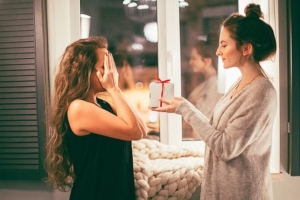
Next, take note of what jewellery they wear. If the person wears a necklace that never gets taken off, buying them another one may not be a worthwhile gift as they are not likely to wear it. However, if they love to chop and change between different rings on their fingers, a special addition to their collection will likely go down a treat.
Finally, look at their style and fashion choices. Are they more into keeping up with current trends or do they prefer a timeless and classic look? Do they like big and shiny bling, or is understated and simple more their thing? All of this will help you narrow your search to a style.
2. Make Sure The Gift Matches The Relationship
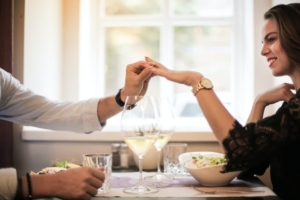
Jewellery, especially something of quality, is often a statement about the relationship you have with the recipient. You wouldn’t necessarily buy the same item for a parent as you would for a significant other, even if both are celebrating a birthday. This is because different types of jewellery have different meanings or symbolism. A ring is seen as a commitment or a promise to someone and is usually reserved for romantic relationships.
The occasion for giving a gift is always a major consideration when shopping. If it’s a milestone anniversary or a big birthday you should definitely consider spending more or going for something a bit more timeless. For the years in between, you could have a bit more fun and think outside the box.
3. Remember That Size Matters
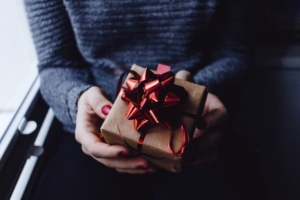
Firstly, the bracelet should fit comfortably around the wearer’s wrist – not too loose or too tight. Secondly, think about the size of the chain and the stones that make up the bracelet. Should they be small and delicate, or big and chunky? Neither is right or wrong on their own, but they can look very wrong on the wearer if they don’t suit their style.
Remember, bigger is not always better if the person will not want to wear it, and this goes for all jewellery types and gemstones too. While you may love the idea of splashing out on a huge sparkler, the recipient may not be wild about wearing such an obvious piece and would prefer a smaller, more subtle gift.
4. Get the Best Quality for your Money
If you are giving a gift that you want to be around for a long time and worn regularly, then quality is of utmost importance.
For one thing, a plated metal will not look good with regular wear. It will start to chip or flake off over time, leaving the cheaper metal below exposed. The worst part about this is the cheaper metal is usually copper or brass, which can leave a nasty green or blue stain on the wearer’s skin. It is much better to go for pure silver if you cannot afford gold or platinum instead of getting something that’s gold plated, as plated will shine nicely to begin with but will not stay that way for long.
5. Ask The Experts
If you are going to make a big purchase, it is always a good idea to get an opinion from an expert with credibility whom you can trust. They can help you appraise the quality of the stones, how secure the settings are, and how well the item will wear over time. You can then buy the piece knowing that you are getting the best value for your preferred price.
When it comes to buying diamonds and other precious stones, it is good to ask for information on the stone. An expert should be able to give you the full report on the stone and offer you alternate options. They should be able to offer you total transparency, and if they cannot divulge the details, it is best to look elsewhere and know exactly what you are buying.
Jewellery makes a wonderful gift for just about every occasion. With this guide, you can ensure that whatever you buy will be treasured and worn for years to come.
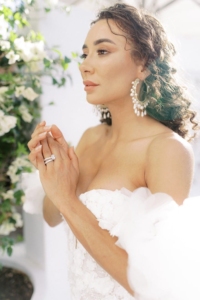
Now it is time to start planning the big special day you have been waiting on. In the beginning it might feel a little overwhelming with so many moving parts to organise. The best thing to do, is to start with one thing at a time. With the average engagement period for many couples today around the 12 – 18months, it is a good idea to start your wedding dress shopping around 9-12 months before the wedding.
Thanks to our friends at White Lilly,
While you might be nervous, excited, anxious about your first wedding dress appointment. It is important to put your trust in your stylist. They are experts at what they do and have helped countless brides find their perfect gown. They will be able to make suggestions about what dress will fit your body shape. They can also help you with any alterations and discuss any fitness regimens you might have in the lead up to your special day.
It is important to also listen to your gut and pay attention to how the gowns make you feel when deciding. You will know “the one” when you put it on, butterflies in the tummy and tears of joy are not uncommon.
Choosing your wedding dress should be an amazing experience. One that you look back on many years from now with fond memories, not just for the dress but those special people in your life you chose to share it with.
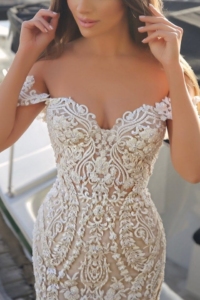
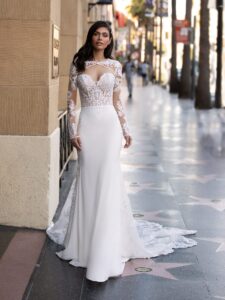
5 Tips for Successful Jewellery Gifting
Jewellery makes for one of those special gifts, perfect for just about any occasion. Afterall, who doesn’t love receiving dazzling jewels to show off?
It can highlight how much you care for a person, and the recipient can show you how much they appreciate the gift by wearing it regularly. Most jewellery, particularly well-crafted pieces, will also turn into a gift that keeps on giving. A person can hand something treasured down through generations as a family heirloom, and you will always be part of that story.
So, how do you make sure that your present will hit the right spot? Follow these 5 valuable tips to picking the perfect jewellery gift and you will nail that gift every time.
When you start to research your gift, the person wearing the jewellery is more important than the jewellery itself. Pay attention to what they already have and what they like to wear. Obviously, it is not a good idea to get them something too like what they already own, but you can certainly draw inspiration from their favourite pieces.
Next, take note of what jewellery they wear. If the person wears a necklace that never gets taken off, buying them another one may not be a worthwhile gift as they are not likely to wear it. However, if they love to chop and change between different rings on their fingers, a special addition to their collection will likely go down a treat.
Finally, look at their style and fashion choices. Are they more into keeping up with current trends or do they prefer a timeless and classic look? Do they like big and shiny bling, or is understated and simple more their thing? All of this will help you narrow your search to a style.
Buying someone a diamond ring for their birthday when you may have only been dating for a short time is probably not going to go down well. On the other hand, a plain chain for a 25-year anniversary is not suitable either. You need to think about how well you know the person, what you mean to each other and what the occasion is.
Jewellery, especially something of quality, is often a statement about the relationship you have with the recipient. You wouldn’t necessarily buy the same item for a parent as you would for a significant other, even if both are celebrating a birthday. This is because different types of jewellery have different meanings or symbolism. A ring is seen as a commitment or a promise to someone and is usually reserved for romantic relationships.
The occasion for giving a gift is always a major consideration when shopping. If it’s a milestone anniversary or a big birthday you should definitely consider spending more or going for something a bit more timeless. For the years in between, you could have a bit more fun and think outside the box.
This goes back to considering the person you are buying the gift for and their specific tastes in fashion and jewellery. Say you have done your research and you have decided on a bracelet as the perfect gift. You need to make sure that your gift fits!
Firstly, the bracelet should fit comfortably around the wearer’s wrist – not too loose or too tight. Secondly, think about the size of the chain and the stones that make up the bracelet. Should they be small and delicate, or big and chunky? Neither is right or wrong on their own, but they can look very wrong on the wearer if they don’t suit their style.
Remember, bigger is not always better if the person will not want to wear it, and this goes for all jewellery types and gemstones too. While you may love the idea of splashing out on a huge sparkler, the recipient may not be wild about wearing such an obvious piece and would prefer a smaller, more subtle gift.
If you are giving a gift that you want to be around for a long time and worn regularly, then quality is of utmost importance.
For one thing, a plated metal will not look good with regular wear. It will start to chip or flake off over time, leaving the cheaper metal below exposed. The worst part about this is the cheaper metal is usually copper or brass, which can leave a nasty green or blue stain on the wearer’s skin. It is much better to go for pure silver if you cannot afford gold or platinum instead of getting something that’s gold plated, as plated will shine nicely to begin with but will not stay that way for long.
If you are going to make a big purchase, it is always a good idea to get an opinion from an expert with credibility whom you can trust. They can help you appraise the quality of the stones, how secure the settings are, and how well the item will wear over time. You can then buy the piece knowing that you are getting the best value for your preferred price.
When it comes to buying diamonds and other precious stones, it is good to ask for information on the stone. An expert should be able to give you the full report on the stone and offer you alternate options. They should be able to offer you total transparency, and if they cannot divulge the details, it is best to look elsewhere and know exactly what you are buying.
Jewellery makes a wonderful gift for just about every occasion. With this guide, you can ensure that whatever you buy will be treasured and worn for years to come.
You might be wondering, What is a temporary engagement ring? It is simply a ring that you can get engaged with NOW, until you find the dream engagement ring. You can still have that amazing proposal experience your partner has been waiting for without the big expense.
But how do you know when you have met the love of your life? Someone who you want to be with through thick and thin. The glorious good times and the really yucky bad times. (that no one tells you about) For me it was the butterflies in my stomach after the first date with my then girlfriend. I am now 22 years married, 4 kids and two massive Newfoundland dogs later. (not by my choice, I got outvoted on that one) The simple answer is, you just know.
Now speaking as a self-confessed control freak, planning to me is everything. If you are nodding along, then welcome to the club. The truth is, life has a funny way of throwing curve balls at us. Covid-19 is certainly one of those curve balls. You, like many couples, were probably blissfully celebrating the start of 2020, thinking that this year was going to be the year that you got engaged. With everything that is going on, you might now be wondering if you have to re-asses your options.
While some of our clients may have lost their jobs due to COVID -19, there are still some that want to take that next step. Understandably a number of clients have been considering whether they should postpone or cancel their planned proposal. Maybe spending $8000 on an engagement ring right now might not be the best thing for you to do.
With so many restrictions in place it is perfectly understandable to think the only alternative is to do nothing and stay at home. Which is certainly the advice coming from the authorities. While that is true in some cases, it doesn’t mean that you can’t get creative with a surprise proposal at home with a temporary engagement ring. A ring that you can go back later and change for the perfect engagement ring. Something that you both can have an input into and enjoy the process.
On the bright side, there have been a number of proposals still going ahead. Albeit much more low key than were originally planned. What is heart warming is talking to a proposer and hearing how despite everything, they are still looking to make their partners year and pop the question.
For many of the proposers I talk to, it can be quite an involved process choosing their partners dream engagement ring. Let alone how and when they are going to propose. With classic proposal locations such as restaurants, or travelling interstate or overseas now off the table, here is a really great alternative.
With every temporary engagement ring purchase we are offering a romantic room turn down service. Imagine turning up with your beloved after a nice walk and coming home to this…
50 x Led Candles
1 x Bag of Red Rose Petals
1 x Bouquet of Red Roses
Fresh Strawberries
Chocolate Dip or Favourite Dessert
Your favourite photo memories displayed of you and your partner
Romantic Music Playing
Champagne
Then all you need to do is get down on one knee open the ring box with your stunning temporary engagement ring and ask your partner the words they have been waiting for. “Will you marry me?”. Your proposal will be special, no matter where it is, or whether it is with a temporary engagement ring. Most partners who I speak to after having been proposed to, are glowing. They are so excited to share about how their partner proposed. They remember what they said and generally how excited they are to be on their way to being married.
Which might come as a much welcome distraction if you are finding yourself stuck at home with a lot more time on your hands. Planning a wedding can take a good 12 months, which means you are all set for a 2021 wedding.
If you have decided that you really want to get engaged to your partner and would love some help. You can book a FREE proposal planning session with me. I guarantee there are some really easy and simple ways to create a romantic proposal that will really blow your partner away. Or have a look at some of our amazing temporary engagement rings here.
An Eternity ring is usually the third ring worn on the engagement ring finger. It usually sits on the side furthest away from you. If your wedding band is a diamond band, it will normally be the same style. However sometimes there can be a few variations. Here are a few of the questions i often get asked about eternity rings.
While your parents might tell you for them it was 10 + years, brides today normally receive their eternity rings after the first year. As much as i would like to take credit for this, it is something that is purely been driven by the ladies. Comments such as “it feels like an eternity already” are not too uncommon.
While normally for symmetry the eternity ring is kept the same size as the wedding band. It is possible to keep the style the same and just increase the diamond size. If you are going to do this it is a good idea to increase the diamond size by more than a few points, so that the variation looks intentional.
Another option for having a larger eternity ring, is if you wish to wear your eternity ring on the ring finger of the right hand. In this case the ring is usually at least twice the width of the wedding band.
Quite simply a full eternity ring is a ring that goes all the way around. Channel set full eternity rings are ideal, as they will generally hold your diamonds more securely. With this style you can have either round brilliant cut diamonds are princess cut diamonds. If you have your heart set on a full circle claw set eternity ring, it is a good idea to have it checked every 6-12 months to ensure that all the stones are tight. With style the diamonds are almost always round brilliant cut diamonds, as the setting is better designed to hold round stones.
Here comes the bad news for the men out there. There is another ring to celebrate the birth of your new baby, and it is called the Maternity Ring or Push Present. Being a father of 4 children myself, i consider it only fair, to buy our ladies some lovely diamonds, in order to NOT go through childbirth, but we will cover more about this in another blog.
In recent times almost every industry has either gone through or is about to go through massive disruption, on a scale never seen before. The diamond industry is by no means immune to the changes that are coming with man made diamonds.
We have seen a marked increase in the enquires around created diamonds in the last month. Some is general curiosity, but most are as a genuine interest in purchasing a man made diamond. Up until recently, there has been little information about them to give a client the complete confidence in their purchase choice. The important thing to remember is that is exactly what it is – a choice. I honestly don’t believe that one will replace the other, just as Uber hasn’t completely replaced Taxis. If you are making an informed decision, you can be comfortable with whichever choice you go for.
Before going into the characteristics of laboratory created diamonds, it is important to understand that there are two main ways to create a man made diamond. High Pressure / High Temperature (HPHT) and Chemical Vapour Disposition (CVD). HPHT process mimics the high pressure that created diamonds in the earth crust. It uses a metal catalyst (graphite/carbon) to dissolve the carbon onto a diamond seed, essentially drawing the carbon out of ferrous metals. Whereas the CVD process in contrast uses low pressure but employs a vacuum which is fuelled with hydrogen and methane. Which means that it derives its carbon source from a vapour. The CVD method starts with a diamond seed crystal to grow the diamond, much the same way you might have grown crystals as a child at school in your science experiment.
You can watch how an Altr created diamond is grown here.
Born of Fire, Born Perfect : The making of a Type IIa ALTR Created Diamond from ALTR Created Diamonds on Vimeo.
Diamonds naturally occur in nature as either a Type 1 (a/b) or Type 2 (a/b) crystal. The most purist and transparent form of Carbon crystal in the world is the Type 2a crystal, it has almost no impurities which leads to the colourlessness and only accounts for 1.8% of the world’s supply and is a rare quality gem.
Every Altr created diamond begins with a Type 2a seed crystal and is guaranteed to be only a CVD diamond, so it’s quality can be assured. Type 2a diamonds have much less nitrogen so they face up looking whiter and crisper, which is in line with their “Shine Brighter” campaign.
So that is most of the technical information out of the way. The simplest take way is that Altr created diamonds have;
When I am showing a client an Altr created diamond, the first thing I will say is one was created below the ground, the other was created above the ground. That is essentially the only difference. Just like if you had two siblings, one was made by IVF and the other through the traditional way, you wouldn’t look at your sibling and call them a synthetic human. They just had a different start, but they are identical to you as a human in every way.
A man made diamond is a very different stone to a Cubic Zirconia or a Moissanite stone, both of which are softer and have different optical properties. Both a cubic and a moissanite are known as stimulants, which means that they are like a diamond, but not the same.
The first thing to look out when shopping for a Laboratory created diamond is whether there is accurate disclosure around the way that it was created. Cheaper versions are made through either straight HPHT, or a combination of HPHT and CVD. If the stone you are looking at purchasing can’t guarantee the method of its creation, then it is most likely a cheaper combination creation stone.
The second thing to look out is for where the diamond was certified. If it is certified by IGI (International Gemmological Institute) it will be a cheaper stone, as the grading parameters for IGI are not as strict as the GCAL (Gem Certification and Assurance Lab). An IGI laboratory has been known to be a colour &/or clarity grade out compared to that of a GIA laboratory. Also, an IGI cert won’t tell you whether your diamond was created through HPHT or CVD.
As mentioned previously the GCAL is one of the strictest grading laboratories’ in the world and completely stands behind their grading. A GCAL cert in addition to the normal 4C’s information also has several additional features
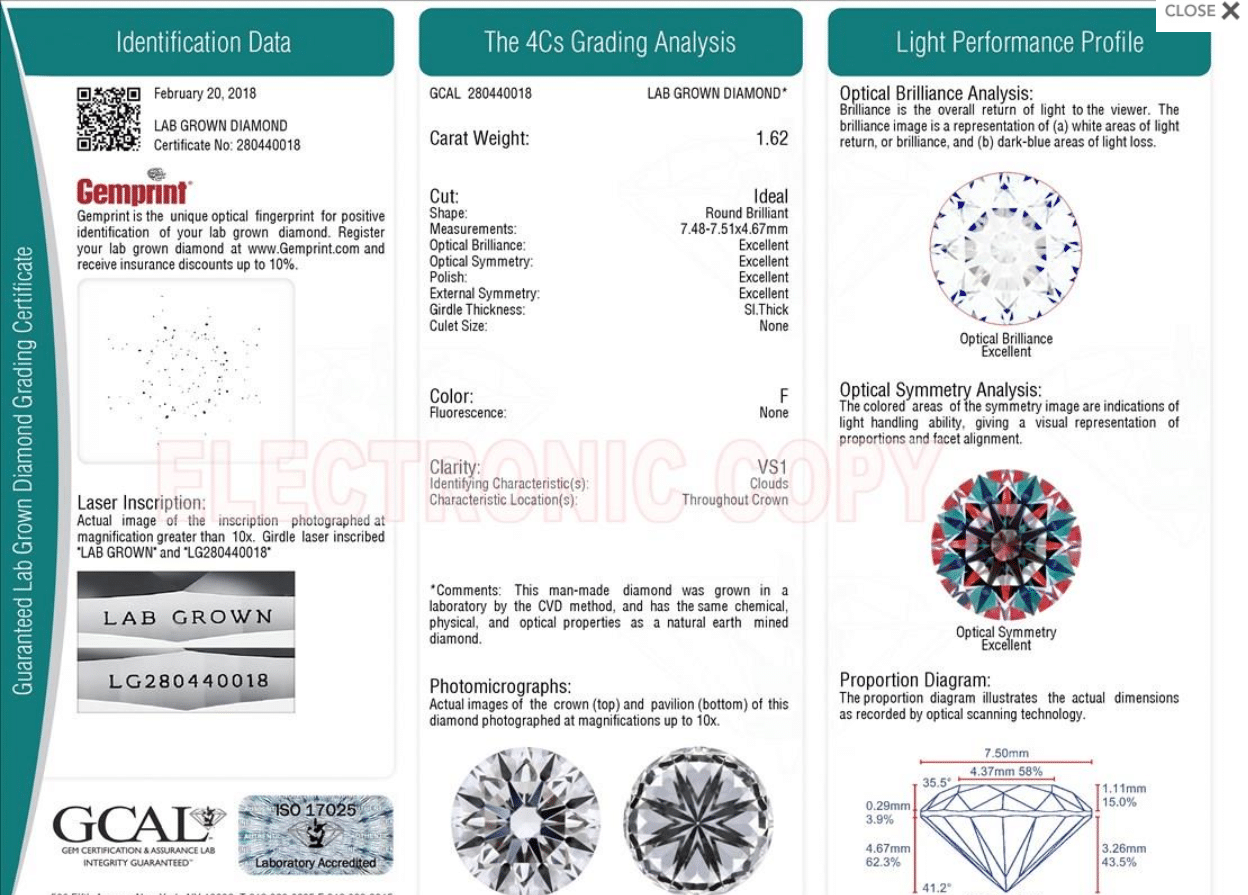 Man Made diamonds GCAL certificate
Man Made diamonds GCAL certificateAll Altr created diamond presses are powered by the earth’s natural wind cycles through the power of wind turbines. This renewable energy source creates the power required to form these amazing gems, ensuring that there is minimal impact on the environment.
Because HPHT created diamonds derive their carbon from a metallic source like iron, the inclusions found in them are often metallic in nature. These inclusions are often easily distinguishable and can even result in the diamond having a magnetic attraction to a magnet.
At the end of the day whether you choose a mined diamond, or a laboratory created diamond, will just come down to your own personal preference. Ultimately the choice will come down to whether it is more important to you that the diamond was created below the ground or whether you would rather have a larger diamond for the same budget. At the end of the day, the best way for you to decide is to compare them side by side and make the choice for yourself. So why not book an appointment and see the diamonds first hand and see if you can tell the difference.
We even have a special promotion on at the moment to celebrate the launch of the Altr created diamonds. You can WIN a .50ct F Colour VS clarity Altr created valued at $2900. All you need to do is book an appointment to come in and see them, to go in the draw to win this amazing diamond.
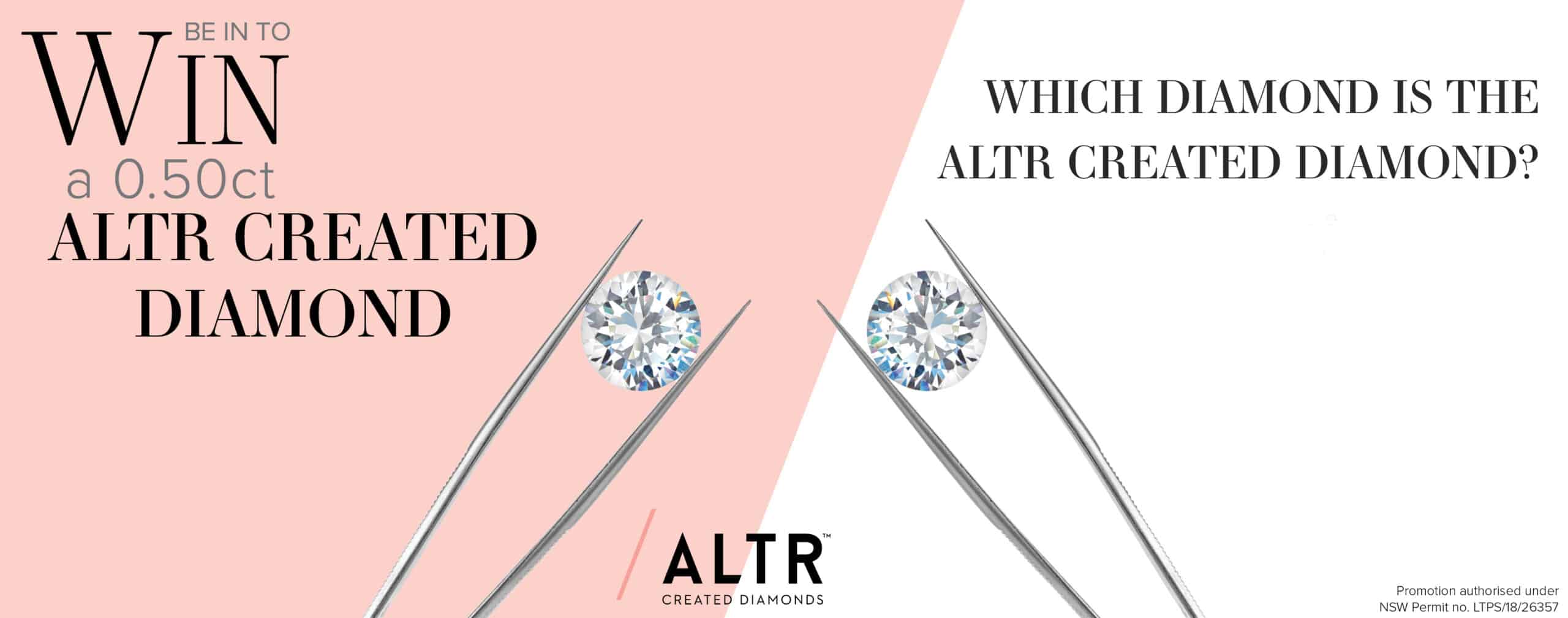
Like most ladies, I am sure you would love to know how to get diamonds for Christmas. I wish I could tell you that guys love shopping for your Christmas present. The truth is most of us hate going near the shops, especially at this time of year. Even worse there is a constant dread of choosing something that you are going to hate. So, what do we do? We procrastinate, we leave it till the last minute, then in the last chance effort, we dash to the shops on Christmas Eve to join all the other helpless guys looking for a present for their partners.
Sound familiar??
I think it is partly because we don’t know what it is you really want, and partly because shopping for us guys is genuinely not an enjoyable experience. I am going to let you in on a little secret – we would rather be watching our favourite sports team, playing on our devices or pretty much anything else than spending hours at a shopping centre.
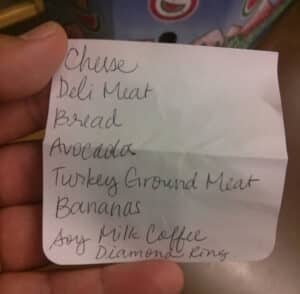
Secondly, tell us the stores that you would love us to shop at for you. Ideally, these stores should have great team members that will make the process easy and a pleasurable experience for us. Ideally, these stores should have ample comfortable seating, be away from the bustling crowds, and have offered us a beer or beverage of our choice while we are picking out your perfect gift.
So If you are tired of receiving the same type of gifts every year, try this new tactic and see if this Santa brings you exactly what you have been dreaming of. Not only will you get more of what you want, but we will actually thank you for making the process of choosing your gift easier for us.

We even have a special promotion running at the moment, to help you get diamonds for Christmas – you can find out more here #LetHerSparkle.
Just as no two individuals are alike, no two jewellers are the same. Every successful jewellery retailer operates in a particular niche. There are some that cater for the mass market, while some are more bespoke. I am not suggesting that everyone must go for the bespoke jeweller. Rather it is important to discover the jeweller who is right for you. Outside of buying a house or car, your jewellery is one of life’s most expensive and important purchases. Although I would argue, it is the most important, as it is rarely ever sold or traded.
Mass market or chain stores will usually have a price advantage because they are working on large quantities of scale. They actually analyse units of cost right down to the gram. Because they know, if they can save half a gram on a ring, then over 10,000 units it will make a significant difference to their bottom line. The unfortunate thing is, this prematurely shortens the life of the ring. The diamonds that are used tend to be from parcel groups. While there are savings to be made from buying diamonds in bulk, what you lose is the ability to hand pick the diamonds.
So you might end up with the best diamond in the parcel, or the worst. Most of the chain stores will also have a very limited warranty period. Most offer after care plans that you have to purchase to help maintain their products. As without this, the clients are likely to run into issues. These product care plans also form a significant recurring revenue stream for these jewellery retailers and can cost you a lot of money in the long run. The type of experience usually received is transactional in style. The staff are trained to show you the items in their cabinet and to help facilitate the transaction, giving you some basic diamond information.
The designs will also more likely be more unique, rather than a vending machine style process, where as soon as you take one out of the cabinet, it is replaced with an identical copy.In a diamond specialist boutique, the diamonds are more likely to be hand selected.
Having your diamond specially selected for you means that you have more control over the diamond parameters, so that you end up with a diamond that’s perfect for your partner.
With bespoke jewellers, you should expect things like a lifetime manufacturing warranty come as standard on the jewellery they craft. It always amazes me when I hear someone who is willing to spend a considerable amount of money on an item that they will have for the next 50 years from someone who is only willing to guarantee it for 12 months. A bespoke jewellery store should offer more of an experience that a mere transaction. It should be less about just forcing you to choose something out of the cabinet because it is convenient, and more about finding the piece that is the perfect fit for you, with an experience you will always remember. Bespoke jewellers generally have more expertise than a generalist jeweller and should be able to answer any diamond questions that you have, so you have complete peace of mind.
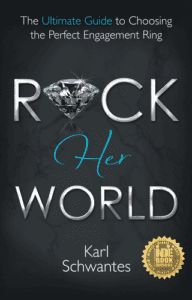
At the end of the day, which store you choose is entirely up to you. As long as it is an informed choice, you can always look back without regrets. Take the time, do your research, have a look at the Google reviews and find the jeweller that’s right for you. If you would like more help in how to choose the perfect diamond and engagement ring, you can find out everything you ever needed to know from the international award winning book – Rock Her World “The ultimate guide to choosing the perfect engagement ring”
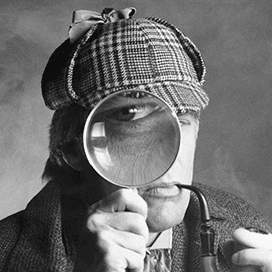 Confused by the diamond certificate?
Confused by the diamond certificate?Have you ever looked at a diamond certificate and had no idea what all the numbers and percentages mean? Don’t worry, you are not alone. Starting out can be a bit daunting, not only do you have to find the ring that she likes but you need to make sure the rock you are putting your hard earned cash into is going to be worth it. The first thing that you are probably familiar with, if you have been paying attention to her subtle hints or done even just a little research is this thing called the 4C’s. They are Cut, Colour, Clarity and Cut Grade. The big question is which one is the most important? You can see my short video series here.
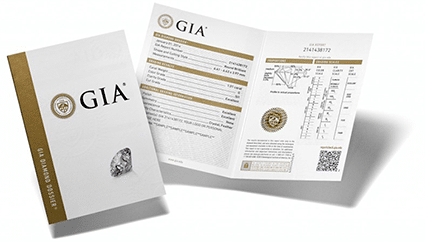
Is only talking about how well the diamond is cut – which ultimately means how much it is going to sparkle. It is that twinkle that her friends will see from across the room. Tip – Aim for an Excellent cut grade. Diamonds like a Passion8 diamond sit in the top 1% for diamond cut and will outsparkle normal excellent cut grade diamonds.
Is only talking about how white the diamond is. This is talking about the body colour of the stone and has nothing to do with the colour. The colour grade starts at D and goes down to Z. Tip – Aim for the top 3 colour grades – D, E, F. Any colour that is G in colour or lower will pull a lot of yellow.
Is only talking about the natural inclusions you can see with a 10x magnifying lens. Tip – Aim for eye Clean SI clarity. As everyone’s eyesight is different make sure you look at the diamond with a lens before purchasing it. Looking at the plot on the diamond certificate will not tell you how good or bad the inclusion is.
Is only talking about the physical size that you see. While this might seem like the most important to some ladies, it isn’t if it is coming at the expense of quality. Smaller more perfectly cut diamonds will actually have the same diameter as larger average cut diamond. Tip – Always go for a diamond that is slightly smaller of better quality. After all, do you want a diamond that looks better or one that weighs more? So now that we have that sorted, let’s look at what all the percentages mean. I wish it was as simple as looking at an excellent cut grade. The truth is the goal posts have widened significantly in the last 5 years. Today more and more diamonds are falling into the excellent category than ever before. 